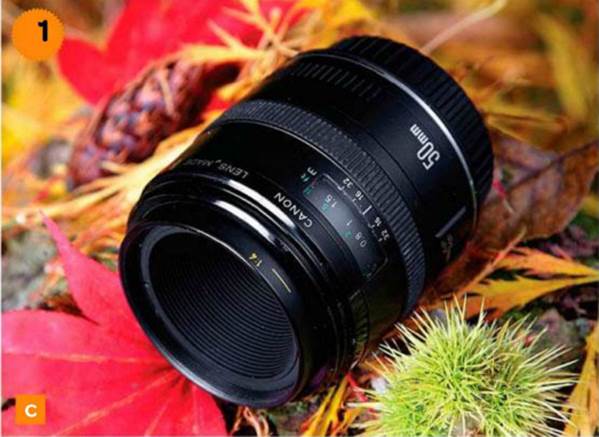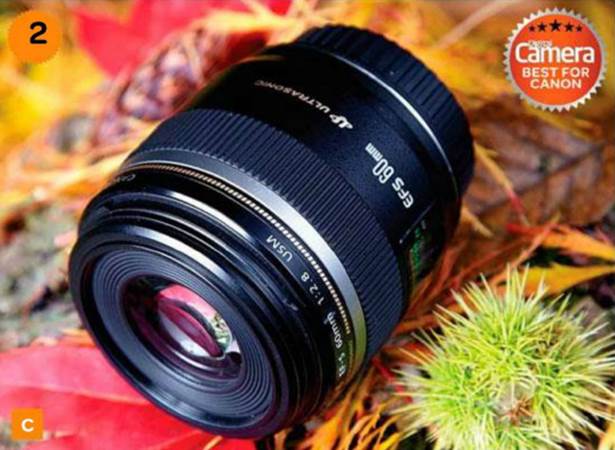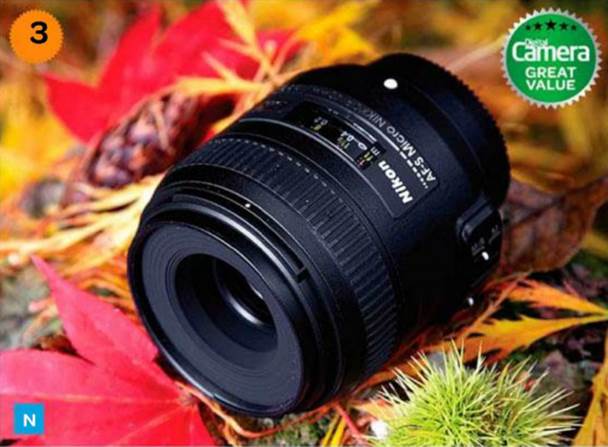For even lighting without shadows, which is
often important in macro photography, the best solution is to use ringflash.
Unlike a regular flashgun or studio flash, the main flash tube forms a ring
that mounts to the front of the lens. Because the flash is effectively fired
from all around the circumference of the lens, any resulting shadows are
minimal.
Most camera manufacturers make ringflash
systems to fit their macro lenses, and independent models are available from
companies such as Metz and Sigma.
Equipment know-how - Features to look for

Make
sure your macro lens suits the way you shoot
Aperture
range
Larger maximum apertures enable faster
shutter speeds at any given ISO. Most lenses in this class are f/2.8, but the
Canon 50mm is one-third of a stop larger and the Tamron 60mm is a full stop
faster.
Autofocus
Ring-type ultrasonic autofocus systems tend
to be fast, quiet and offer a full-time manual focus override. Some lenses have
no internal focus actuator and rely on a screw-drive from the camera body.
Focal
length
The effective focal length is magnified by
1.5x for Nikon, Pentax and Sony
bodies with APS-C sensors, and 1.6x for Canon. Four Thirds and Micro Four
Thirds cameras have a 2x multiplier.
Internal
focusing
This is preferable, especially for lenses
with a short focal length, as the lens doesn't extend at shorter focus
distances. So you can maintain more distance between the front of the lens and
what you're shooting.
Image
circle
Some lenses can be used with full-frame and
APS-C cameras, but the Canon EF-S, Nikon DX and Tamron Di II lenses are
designed for APS-C bodies. The Olympus lens is built for a Micro Four Thirds
fitment.
Focus
limiter switch
This limits the focus travel to only
medium-infinity focus distances or, in some cases, either side of a medium
focus point. It speeds up autofocus, as the lens doesn't have to hunt through
its entire travel range.
Canon EF 50mm f/2.5 Macro

An oldie that gets halfway there
First launched all the way back in 1987,
this veteran lens is still in production 25 years later, so it’s certainly
stood the test of time. Frills are few, with the fitment of only a standard
micro motor for autofocus. The manual focus ring is disappointingly thin,
there’s no focus limiter switch and overall construction quality is mediocre.
At least the front of the lens is designed to accept fitment of Canon’s
ringflash.
Like most Canon lenses, this one comes
without a lens hood, but you really don’t need one, as the front element is recessed
very deeply within the barrel. The inner barrel extends at closer focusing
distances and is marked with magnification ratios. However, these are only
correct when you’re using the optional Life-Size Converter, which costs an
additional $330. In standard trim, the lens only achieves a maximum
magnification of 0.5x, but the converter takes it up to a full Ix, while also
reducing the largest available aperture to 173.5.
Performance
Autofocus is fairly slow and noisy. The
lack of a limiter switch further hampers focusing speed, because the focus
travel is very long. On the plus side, the extended travel makes for precise
manual focus adjustments, which is especially important for macro shooting.
Even so, a bigger focus ring would greatly improve handling. Image quality is
disappointing too, with a real lack of sharpness at large apertures, as you’ll
see from our lab test results on page 130.
Tech
focus
Nine elements in eight groups, six
diaphragm blades, closest focus distance 23cm, 52mm filter thread, electric
motor autofocus, physical dimensions 68x63mm, weight 280g
|
Details
·
Price: $345
Verdict
·
Features: 3/5
·
Build quality: 3/5
·
Image quality: 3/5
·
Value: 3/5
·
Overall: 3/5
|
Canon EF-S 60mm f/2.8 Macro USM

Canon’s up-market macro
Canon’s newer 60mm lens is more refined
than its 50mm offering. A ring-type ultrasonic actuator aims to deliver fast,
near-silent autofocus, complete with full-time manual override. Fully internal
focusing means that the front element neither rotates nor extends as you go
from infinity to the shortest focus setting of 20cm, where the lens delivers
full 1x magnification instead of the other Canon’s under-achieving 0.5x. 60mm
is a good choice of focal length on Canon cameras like the 650D, 60D and 7D, as
the crop factor gives a very macro-friendly effective focal length of 96mm.
The lack of a supplied lens hood is more of
an issue than with the Canon 50mm lens, as the larger front element is
positioned right at the front of the barrel. The official, optional ET-67B lens
hood costs $45. One similarity between the two Canon lenses is that they both
feature a mounting ring for fitting the Canon MR-14EX ringflash. It’s pricey,
however, at $690.
Performance
For general shooting, autofocus is quick
and quiet, despite the lack of a focus limit switch. The missing switch isn’t
too much of a pain because the overall focus travel is very small for a macro
lens. The downside is that the very small, precise manual focus adjustments
that you often need for macro shooting are difficult to achieve. This is
despite a physically larger focus ring, which is about twice the width of the
one fitted to the Canon 50mm lens.
Tech
focus
12 elements in eight groups, seven
diaphragm blades, closest focus distance 20cm, 52mm filter thread, ultrasonic
(ring-type) autofocus, physical dimensions 73x70mm, weight 335g
|
Details
·
Price: $525
Verdict
·
Features: 4/5
·
Build quality: 3/5
·
Image quality: 4/5
·
Value: 4/5
·
Overall: 4/5
|
Nikon AF-S 40mm f/2.8G DX Micro

Nikon’s bargain macro lens
With a different design philosophy to
Canon’s 60mm macro lens for APS-C cameras, Nikon serves up a shorter focal
length of 40mm. The ‘effective’ focal length is 60mm instead of the Canon’s
96mm, so it’s closer to a 50mm than a short telephoto - good for general
shooting, but a compromise for macro photography.
Like the Canon 60mm, this lens is fitted
with ring-type ultrasonic autofocus, but the Nikon comes complete with a focus
limit switch. You can’t lock it to a short-to-medium range, but you can lock
out the close-up range for general shooting. Focusing then only operates in the
2cm-mfinity range.
The front element doesn’t rotate during
focusing, but the barrel does extend towards close focus settings. At its
minimum focus distance of 16.3cm, the front of the lens is only about 3.5cm
from the object you’re shooting, so lighting can be problematic. Nikon’s
cheapest R1 macro flash kit weighs in at about $623.
Performance
For a ring-type ultrasonic system,
autofocus speed is slow, so the focus limit switch is a worthwhile inclusion.
This locks out more than half the travel at the close-up end. The amount of
overall travel is quite small for a macro lens, making precision manual
adjustments fiddly for close-up shooting. The problem is compounded by the
focus ring lacking smoothness, but the lens redeems itself with its image
quality, which is superb throughout the entire aperture range.
Tech
focus
Nine elements in seven groups, seven
diaphragm blades, closest focus distance 16.3cm, 52mm filter thread, ultrasonic
(ring-type) autofocus, physical dimensions 69x65mm, weight 235g
|
Details
·
Price: $293
Verdict
·
Features: 3/5
·
Build quality: 3/5
·
Image quality: 4/5
·
Value: 4/5
·
Overall: 4/5
|